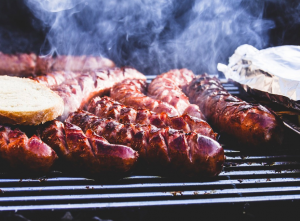Struggling to get into a busy farmers market in your town? Here’s our advice for getting your application noticed and accepted. This process works for food trucks, trailers, and pop-up tents.
As a general rule of thumb, farmers market applications are available on the website or social media page for the website. If not, you can ask the Market Manager to add you to the list of possible vendors who they send an application to annually (usually via email). The first step is filling our an application correctly and sending the document to the manager.

BBQ grilling is better as a team sport.
1. Sell something not sold at the market already
If you sell something three vendors already sell, you can probably guarantee you’re not going to get in. You may get in as a day vendor (who subs when a permanent vendor can’t make it), but there are no guarantees. That means the best way to get noticed is to sell something the market has never seen before.
2. Support local producers
Working with farmers to use their produce in your products is a surefire way to get to the top of the consideration pile. Many applications ask who you’re working with, so make sure to include a couple local businesses.
3. Send Samples (if requested)
So you make the world’s most amazing empanadas? (I’d love to try them). If you’re allowed, get samples in front of the selection committee. Find a way for them to sample your food products after all, a pitch in person is way better than a pitch on paper.
4. Take time to fill out your application.
Tell your story, attach pictures (if requested), and get your application in early. This not only shows your initiative, but you’ll have the most important task done. That means more time to focus on growing your sales at your farmer’s market debut.
A quick note about being waitlisted….
Our first farmer’s market was in Williston, the next town over from us. We didn’t do the farmer’s market in our own town because there were too many vendors. It was a slow market maybe $1500$250 a weekend. Enough to meet the financial needs of a student.
We added a second market the Essex Farmer’s Market on Friday nights. It was a better location, more lively, and we pulled in $250$350 a market (on a good, non-rainy day).
But, I heard of greener (read: more money) pastures…
The Burlington Farmer’s Market was where I needed to be. While it was 56 times more expensive than our current market, it attracted between 5,000 and 8,000 people every weekend. And for Vermont standards, that’s PACKED. We applied thinking we were a shoe in.
No one was selling mustard, I was young, and had built a small following. Wrong. I was on the waitlist for 2 years before I became a substitute vendor.
Our first season, we were at the market sporadically maybe four or five markets And it was usually raining. We still did well $300. In the rain.
Now, we’re a full-time summer vendor.
Green Mountain Mustard has now been at the Burlington Farmer’s Market three seasons two have been full-time. And over the course of 6 months, we’ll pull in $13,000 $15,000 averaging $520 a market. Our best market was $816.
My point? The waitlist is not the end of the world.
Keep applying. Maybe you’ll get in as a substitute vendor next year. Then, be nice to everyone, create a great impression with customers, and apply again. You’re more likely to get in with some experience under your belt and the willingness to come when the weather sucks (that means you’re dedicated to the market!).
Don’t get discouraged.
5. Keep applying.
Look at other markets the next town over. Sometimes it’s better to start small anyway. You’ll get a chance to learn how farmer’s markets work, talk to your small legion of customers, and prepare yourself for bigger, more lucrative, markets.
If you’ve been eyeing a particular farmers market or craft fair, we hope this process helps you book more lucrative events.

Leave A Comment